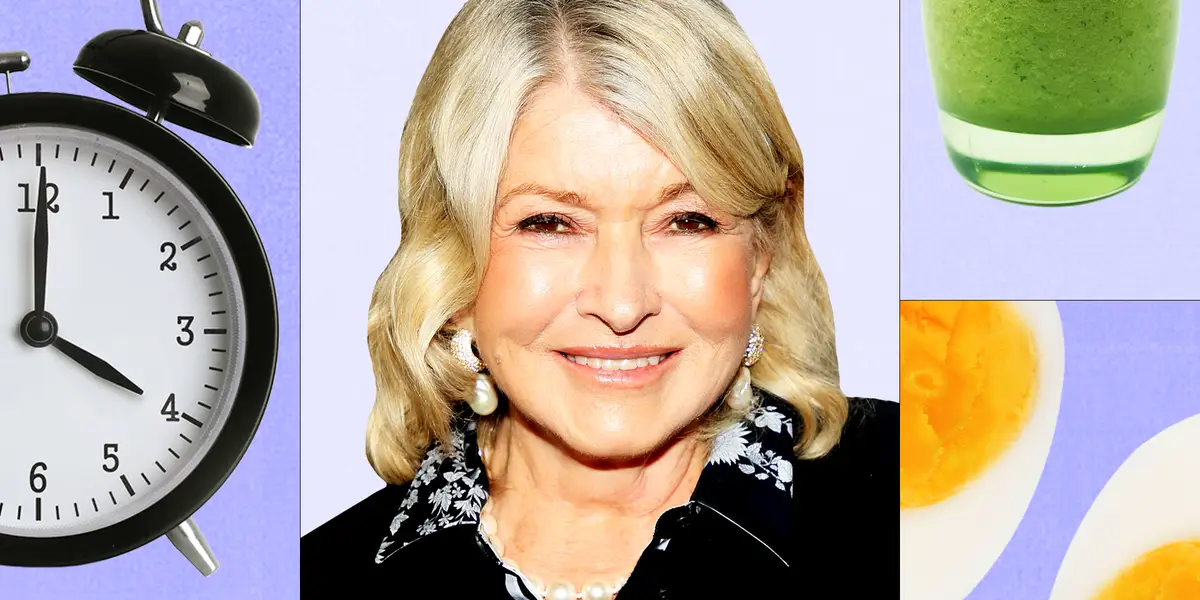Copyright Business Insider

During a September appearance on the "Lipstick on the Rim" podcast, which model Molly Sims hosts alongside her friend Emese Gormley, Stewart outlined her morning routine. "[My] typical day starts early — I wake up around 4-4:30 a.m.," she said. "I read the entire New York Times. I do all the puzzles. I do Letter Boxed. I do Tiles. I do all of those silly games, but it's good for your brain. It's just good. And then I go to Pilates or I go to the gym." After working out, Stewart drinks green juice, which she makes from homegrown vegetables like spinach, cucumber, parsley, orange, and celery, with a bit of store-bought ginger. She then has a whole-milk cappuccino and yogurt made from cream-top whole milk, served with wheat germ and one home-raised egg, either boiled or scrambled. Living on a farm, Stewart said she likes to be up before her staff arrives at 7 a.m. to "show them that you're as lively as they are." With these parameters in mind, I followed her routine for one workweek, from Monday through Friday, to see if the media mogul could teach me any morning habits that would set me up for a productive day. The first day I tried waking up at 4 a.m., I failed miserably. The night before, I had gone to sleep at my usual time of 10:30 p.m. to 11 p.m. after finishing my weekend chores and prepping for the week. Unfortunately, my bedtime was just not compatible with Stewart's ultra-early routine. When my alarm woke me, I was groggy, had a headache, and was half awake at best. The light from my phone screen roused me enough to read a few New York Times stories, but before I could get to any games, the reading lulled me back to sleep … until 7 a.m. By the time I really woke up, I barely had time to get ready and rush out to the office, skipping the breakfast, games, and Pilates I had planned to do. It was a messy start to the week and felt like a bad omen, but I persevered. By day two, I had learned an important lesson: I would not succeed unless I was strict about going to bed at 8 p.m. each night. While Stewart said her bedtime varies, often because she's hosting or attending events in the evening, I realized I needed to stick to a bedtime that allowed me to get enough sleep. (Experts recommend seven to nine hours of sleep each night.) However, this schedule left me with only 1 ½ hours to myself after getting home from work, including time to wind down and get ready for bed. This meant giving up pretty much all after-work activities, from socializing to catching up on chores. Having to sleep so soon after getting home was the hardest part of this challenge, as it left me feeling as if every minute of my day, asleep or awake, was on a strict schedule. But while going to bed at 8 p.m. wasn't the best fit for this 23-year-old's lifestyle, it definitely made the 4 a.m. alarm on Tuesday a lot less painful. I fully woke up at 4:07 a.m. and spent about an hour in bed reading politics, international news, and opinion pieces on The New York Times. Then it was time for some New York Times games. Stewart said she includes games in her morning routine to help her stay mentally sharp — experts say mentally stimulating activities can help delay or protect against cognitive declines. So I completed the Mini, Wordle, Connections, and Strand games before I got up. After my brain got a workout, it was my body's turn. I put on exercise clothes and headed to my building's basement gym, which I thankfully had to myself, and followed an at-home Pilates video. Pilates, which is designed to help strengthen core muscles, improve flexibility, and improve sleep and mood, features low-intensity movements designed to build strength without the use of heavy weights. The video I followed included stretching and a focus on core exercises, but it also worked muscles in the legs and arms by instructing me to make small "pulsing" movements in different positions. About an hour later, at 6 a.m., I returned to my apartment, took a quick shower, got ready for work, and then began making Martha's breakfast, including her signature green juice, which she drinks every day. Not having a juicer or a juice extractor, I opted to blend all the ingredients instead. These included: • Spinach • Celery, with the leaves • Cucumber • Parsley • Ginger • Half an orange, with the rind Rather than following a recipe with specific measurements — which Stewart does not give — I put as much of each ingredient as I could in my small blender. I then filtered that mixture, which was thick and full of vegetable fibers, through a cheesecloth to extract the juice, squeezing it with my hands to speed up the process. This took me a lot longer than I expected — I spent about 20 minutes chopping, blending, and squeezing vegetables for about a cup of juice. While I was dedicated to following the routine, I wouldn't go through all this trouble on a daily basis just to drink some greens I could be eating in an easy-to-assemble salad instead. As well as juice, I ate whole-milk yogurt (Stewart usually makes her own, but for the first day, I had store-bought) topped with wheat germ and one boiled egg. The breakfast, which has protein from the yogurt and egg and fiber from the wheat germ, felt balanced and was a filling start to the day. Still, I couldn't fully get on board with how it all tasted. I wasn't sure what texture to expect from the wheat germ, but once I mixed it with the store-bought Greek yogurt, it formed a thick, grainy paste that tasted like … nothing. Meanwhile, the juice was very bitter, which I assumed came from the orange rinds, and I wondered how nutritious it really was. While the juicing process often maintains vegetables' vitamins and minerals, it gets rid of nearly all the fiber they provide in their pure form or when they're used in a smoothie. While yogurt is not usually a recipe I'd care to make, I wanted to replicate Stewart's breakfast as closely as I could. Plus, it allowed me the rare opportunity to try the yogurt function on my Instant Pot. It was far easier than I thought. All I had to do was mix a half-gallon bottle of cream-top whole milk with 2 tablespoons of store-bought yogurt containing live and active cultures. It was similar to Stewart's own recipe. I set my Instant Pot to the yogurt option, which keeps the milk mixture at a very low heat for 12 hours, and closed the lid, letting it do the cooking while I headed out to work. When I got home, I moved the pot to the fridge, where it stayed overnight. The next morning, the yogurt was ready for breakfast. A lot runnier than the Greek yogurt I had the day before, this yogurt was silky, buttery, and surprisingly tasty. The recipe made enough to fill nearly three full 24-ounce deli containers. On Wednesday, I woke up around 4:30 a.m. Trying to follow Stewart's habit of reading the entire New York Times was proving to be a challenge. I felt like I was rushing through the stories, and I wished I could've sat with the subjects a bit more. On this day, I read about six full articles before moving on to the games. However, knowing I had to be out of the door by 6 a.m. for a Pilates class, the games felt more frustrating than enticing. Every mistake was costing me minutes in my tight schedule. After completing a few, I headed out for the class at a studio in my neighborhood. After the early workout, breakfast was amazing … thanks to a few customizations. I made the green juice sweeter by using a whole orange instead of half, and by letting it strain overnight instead of squeezing it through cheesecloth, which made it come out significantly less bitter. To the yogurt, I added some wheat germ (not as much as the day before) and customized it to my taste by adding walnuts, blueberries, and honey. The added toppings made the yogurt bowl irresistible, and a sweeter green juice made me appreciate its freshness, which made me feel brighter and lighter. With a couple of tweaks, Stewart's breakfast became one of my favorite things to have in the morning. On Thursday, I felt sleepier and had some trouble waking up. Although I was beginning to get used to earlier waking times, it was still a big change for my body. By the time I got out of bed — after reading a few articles but opting to skip the games — I didn't feel like leaving my apartment, so I rolled out of bed onto my yoga mat for a bedside workout. Being in an apartment in New York City, my space is minimal, but I managed to fit my yoga mat between my desk, console table, bed, and wall. I followed a workout video, which was hard, both physically and spatially. My legs and arms touched every surface around me. Every time I hit my hand on the wall or accidentally kicked my table, I thought of how much of a non-problem this is for Martha Stewart. By Friday, I noticed that my mood in the mornings was improving. Instead of feeling defeated by the ultra-early alarm, I saw it as an opportunity to use the quiet morning hours to do things that I wouldn't make time for otherwise. My body seemed to be getting used to this new schedule, because I hardly had any trouble waking up at around 4:15 a.m. on Friday. Once I was awake, I used my first moments to breathe, set some intentions for the day, and then jump into my New York Times reading. This time, I started with some lighter topics, like culture and wellness, rather than immediately reading the top stories of the day, which often cover politics and economics. The change in my media intake helped me focus on myself during the early morning, rather than immediately giving me a sense of doom. I headed out for another class and embraced the journey there by listening to some podcasts about the science of the human brain. It's been over a week since my experiment ended, and since then, I have stuck to my own version of it. I learned that I really enjoy having a morning routine focused on movement and enrichment, and I have since taken three 6:30 a.m. Pilates classes, followed a few at-home Pilates and yoga videos, ate the rest of my homemade yogurt, and even made a batch of green juice to drink throughout the week. While Martha Stewart's sleep schedule is incompatible with my 20-something lifestyle (even at my most responsible), the structure and enriching habits of her routine set me up for successful days. I understand why she credits her mornings for her success in business and her healthy aging. I have now settled on a more manageable 5:30 a.m. to 6 a.m. wake-up time, which still allows me to have a slow and productive morning without having to plan my entire day around my sleep schedule. I am also finding ways to fit my social life into the mornings, such as inviting friends to join me at Pilates classes or meeting them at coffee shops for morning coworking sessions. I did sleep in on the weekend after my weeklong experiment, but I sense a lifestyle change underway.



